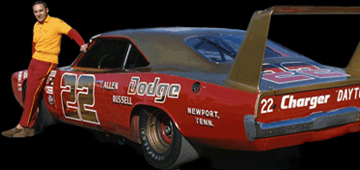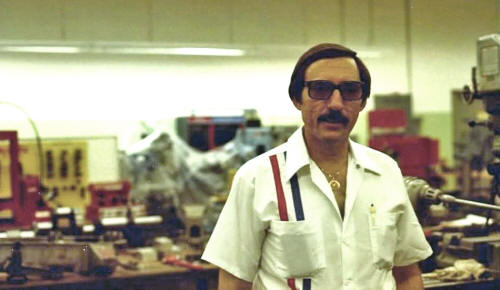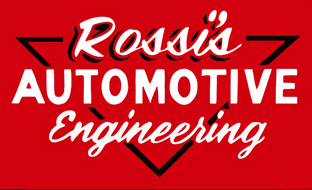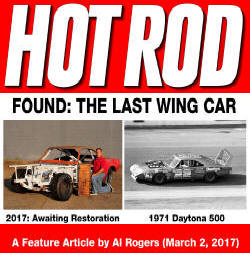The
March 2, 2017, online issue of HOT ROD Magazine contains an excellent
article by Al Rogers on the current restoration status of the Rossi
Engineering 1969 Dodge Daytona. Bill Rossi, son of legendary car owner
& mechanic Mario Rossi, purchased the car in 2013. The Dodge Daytona
was the last winged car to compete in the Monster Energy NASCAR Cup
Series. Its final race was the 1971 Daytona 500, contested on
February 14, 1971. After completion of the 1970 season,
NASCAR president Bill France decided to end the dominance of the
specially constructed “aero cars” by limiting their engine size to 305
cubic inches. Rossi and his driver, Porterville, California
native Dick Brooks, were the only team that fielded an “aero car” for
the race, as the other teams opted for the ability to run the larger
engines. While the other Dodge and
Plymouth
cars at Daytona were powered by the proven 426 cubic inch Hemi engine,
Rossi’s 1969 Dodge Daytona was equipped with a relatively small 305
cubic inch engine built by Californian drag racer Keith Black. Brooks
would lead 5 laps in the event and finish in 7th position, after losing
two laps due to a collision with Pete Hamilton’s
Plymouth.

 Mario
Rossi, the hardworking son born of Italian immigrants, operated a
high-performance automotive shop in his hometown of Trenton, New
Jersey, before joining the NASCAR Grand National
series in 1955. In his first
Grand National appearance, Rossi finished an impressive ninth in a 250
mile event held at
Pennsylvania’s Langhorne Speedway.
In the late fifties, he would
move south and work as a mechanic for various NASCAR legends such as Tom
Pistone, Smokey Yunick and Bud Moore.
Mario
Rossi, the hardworking son born of Italian immigrants, operated a
high-performance automotive shop in his hometown of Trenton, New
Jersey, before joining the NASCAR Grand National
series in 1955. In his first
Grand National appearance, Rossi finished an impressive ninth in a 250
mile event held at
Pennsylvania’s Langhorne Speedway.
In the late fifties, he would
move south and work as a mechanic for various NASCAR legends such as Tom
Pistone, Smokey Yunick and Bud Moore.
In 1968, Rossi began fielding his own cars for
NASCAR Grand National competition with financial support coming from
Chrysler Corporation. In the Spartanburg, South Carolina-based Rossi
Engineering team’s first race, veteran driver Darel Deringer piloted
their 1968 Plymouth Roadrunner to a 23rd place finish in the
1968 Motor Trend 500 at Riverside, California.
Deringer and the team competed in 18 races during the 1968 season
with 5 top-five and 8 top-ten finishes. Deringer would wind up 21st
in the NASCAR Grand National driver point standings for 1968.
For the 1969 season, fan favorite Bobby Allison
would join forces with Rossi Engineering for the Grand National series.
The team would switch to the 1969 Dodge Charger 500 body style for
NASCAR competition. During the
season, Allison would record 23 starts for the team and collect
victories at Bristol, North Wilkesboro,
Richmond and Macon. He would also compete in three races
for Rossi Engineering in the aerodynamic Dodge Daytona, beginning with Charlotte’s
National 500 in October.
During the season, Allison would amass 12 top-five and 13 top-ten
finishes en route to a 20th place finish in the 1969 series
standings.
The start of the 1970 season would find Allison and
the Rossi Engineering team building on the successes of the 1969 season
as they recorded a 3rd place finish in the
Daytona 500 in the Dodge Daytona.
Allison and the Daytona would go on to capture the
Atlanta
500 by a narrow margin over Cale Yarborough in the Wood Brother’s
Mercury. The Rossi
Engineering team would also claim the Union 76 Pit Crew title as Mario
Rossi introduced the now standard procedure of gluing the lug nuts onto
the wheels to enable quicker tire changes while the car is in the pits.
Allison would pilot the Rossi Engineering Dodges to 13 top-five
and 14 top-ten finishes. He
would also drive his own Dodge Charger in selected events as the Rossi
Engineering team only concentrated on the higher paying events conducted
on larger tracks. Allison
would finish 2nd in the NASCAR Grand National points
standings by a slim 51 (3,911 to 3,860) point margin to champion Bobby
Isaac. Unfortunately, Allison would leave the Rossi Engineering team at
the end of the 1970 season to begin building his own team for the 1971
season.
Perhaps Rossi’s most notable accomplishment during
the sport came the 1971 Daytona
500, when he campaigned a heavily horsepower-restricted Dodge
Daytona in the event. After
completion of the 1970 season, NASCAR president Bill France decided to
end the dominance of the specially constructed “aero cars” by limiting
their engine size to 305 cubic inches.
Rossi and his driver, Porterville, California
native Dick Brooks, were the only team that fielded an “aero car” for
the race, as the other teams opted for the ability to run the larger
engines. While the other Dodge and
Plymouth
cars at Daytona were powered by the proven 426 cubic inch Hemi engine,
Rossi’s 1969 Dodge Daytona was equipped with a relatively small 305
cubic inch engine built by Californian drag racer Keith Black.
Brooks would lead 5 laps in the
event and finish in 7th position, after losing two laps due
to a collision with Pete Hamilton’s
Plymouth.
This would be the last appearance of an “aero car” in NASCAR
competition as the Rossi Engineering Dodge Daytona would be parked after
the race. Brooks and the
team would go on to record 9 top-five and 12 top-ten finishes during the
remainder of the season.
At the completion of the 1971 NASCAR Grand National
season, Rossi closed up his shop. He sold both his equipment and race
cars as the tough Italian had became disenchanted with the direction
NASCAR was taking. He did
make a comeback of sorts in 1973, as he went to work for the heavily
financed DiGard Racing organization as team manager.
After well-publicized run-ins with team driver Darrell Waltrip,
Rossi left both DiGard and NASCAR in 1976. He would make one more Grand
National start, that coming in the
1976 Dixie 500, working as crew chief for driver Ford driver Richie
Panch. After completion of the race, one of the greatest innovators,
mechanics and crew-chiefs in NASCAR history called it quits.
Rossi settled in south Florida after leaving the world of NASCAR
Grand National racing. He
came home in December 1982, to spend Christmas with the family in Trenton.
By all accounts the Rossi family had a wonderful time together
and enjoyed all the usual holiday festivities.
His sister drove him to the
Philadelphia
Airport on December 30th
and dropped him off at the terminal door.
Rossi waved to her as he headed into the terminal to board his
plane. That would be the
last time he would be seen by the family.
Rossi’s sister received a mysterious call from an unidentified
party on January 2, 1983, stating that her brother was dead.
To this date the disappearance of Mario Rossi
remains unsolved…..

HOT ROD Magazine Article



 The
March 2, 2017, online issue of HOT ROD Magazine contains an excellent
article by Al Rogers on the current restoration status of the Rossi
Engineering 1969 Dodge Daytona. Bill Rossi, son of legendary car owner
& mechanic Mario Rossi, purchased the car in 2013. The Dodge Daytona
was the last winged car to compete in the Monster Energy NASCAR Cup
Series. Its final race was the 1971 Daytona 500, contested on
February 14, 1971. After completion of the 1970 season,
NASCAR president Bill France decided to end the dominance of the
specially constructed “aero cars” by limiting their engine size to 305
cubic inches. Rossi and his driver,
The
March 2, 2017, online issue of HOT ROD Magazine contains an excellent
article by Al Rogers on the current restoration status of the Rossi
Engineering 1969 Dodge Daytona. Bill Rossi, son of legendary car owner
& mechanic Mario Rossi, purchased the car in 2013. The Dodge Daytona
was the last winged car to compete in the Monster Energy NASCAR Cup
Series. Its final race was the 1971 Daytona 500, contested on
February 14, 1971. After completion of the 1970 season,
NASCAR president Bill France decided to end the dominance of the
specially constructed “aero cars” by limiting their engine size to 305
cubic inches. Rossi and his driver, 
 Mario
Rossi, the hardworking son born of Italian immigrants, operated a
high-performance automotive shop in his hometown of
Mario
Rossi, the hardworking son born of Italian immigrants, operated a
high-performance automotive shop in his hometown of 